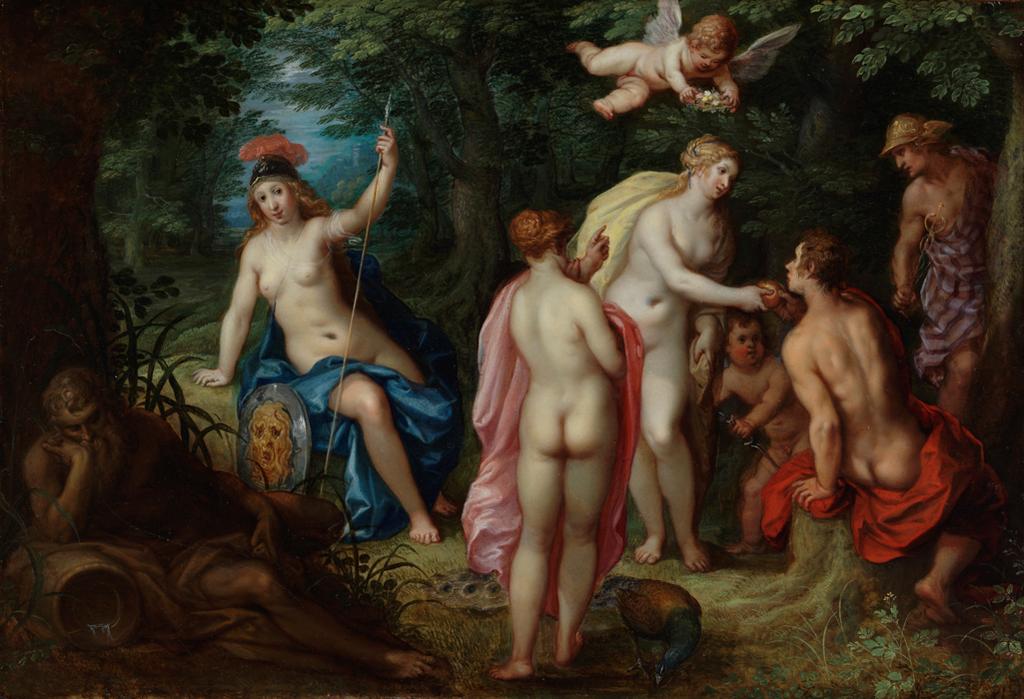Athena or Minerva
I begin to sing of Pallas Athena, the glorious goddess, the bright-eyed one, resourceful, with an implacable heart, a pure maiden, the valiant protectress of cities.
Homeric Hymn 28, 'To Athena'
Athens, modern Greece's capital and one of the most powerful of the ancient Greek city-states, is named after the goddess of wisdom, Athena, also known as Pallas Athena, or Minerva to the Romans. She appears left on a silver Athenian coin from c. 450 BCE in the Fitzwilliam (CM.383-1978), accompanied by her symbol, the owl.
The Parthenon on the Athenian Acropolis was a fifth-century BCE temple dedicated to the goddess. The Greek word parthenos means maiden, and in myth Athena is distinguished by her chastity. A vast cult statue made of gold and ivory once stood in the Parthenon, the creation of the Greek sculptor Pheidias, and it has been suggested that the statue from which the bust in Batoni's painting was copied was based upon this lost masterpiece. Left is a cast of a second- or third-century CE Roman marble statuette based on Pheidias' work, from the Cambridge University Museum of Classical Archaeology.
It was said that Athena had struggled with the sea god Poseidon (Roman Neptune) for the possession of Athens and its surrounding lands. The king of the gods, Zeus (Jupiter), decreed that the area should come under the patronage of whichever of the two deities gave Athens the most beneficial gift. Poseidon straightaway stuck his trident into the earth from which sprung salt water. But Athena won the contest by causing an olive tree to grow and bear fruit. This struggle was depicted in part of the sculptural decoration of the Parthenon.

The Judgement of Paris (416), an early seventeenth-century painting by the Flemish artist Hendrik van Balen I in the Fitzwilliam, shows Athena involved in another competition with her fellow deities, this time Hera (Roman Juno) and Aphrodite (Venus). The Trojan prince Paris was asked to judge which of the goddesses was the most beautiful. Athena offered to reward him with martial prowess and wisdom if she were given the prize. Here we see her almost entirely naked, but for a richly plumed helmet – hardly a model of chastity in this case. Paris has just awarded the prize to the goddess of love, Aphrodite, who is accepting the golden apple from him as she is crowned from above by a flying Cupid.
Athena was known as a war goddess before she became a goddess of wisdom. Legend held that she was born fully armed from the head of her father Zeus, and she is traditionally depicted carrying a shield, wearing a helmet and wielding a spear. She played an important part in the victory of the gods over the giants, an epic battle that was often depicted in Greek art. And she was the divine ally of several heroes. Herakles, for example, often received her help and support. She can be seen encouraging him on a fifth-century Athenian black-figure wine jug in the Fitzwilliam (GR.7.1937), as he wrestles with the lion of Nemea.
Perseus, the slayer of the Gorgon, also benefited from Athena's help. A drawing by the mineteenth-century artist Edward Burne-Jones in the Fitzwilliam [2012] shows the naked goddess preparing to arm the hero. In gratitude Perseus gave Athena the Gorgon's head, one look at which would turn the viewer to stone. This was used as the centrepiece of her aegis, a cloak made of goatskin and fringed with serpents. She is often depicted wearing this garment, for example on the wine jug illustrated above.
Athena is credited with the invention of the flute, and she was associated with homely skills such as spinning and weaving. It is probably as a general patroness of the arts that she appears in Pompeo Batoni's portrait of the earl of Northampton: a kind of pagan patron saint to Grand Tourists, a figure who embodies the intellectual and antiquarian interests of this widely travelled, well-read young man.
She appears in another eighteenth-century work in the Fitzwilliam, The Allegorical Monument to Sir Isaac Newton (PD.52-1973), by Pittoni and the Valeriani brothers, detail left. Here, plucked from ancient myth and religion, still wearing her warrior's helmet, the Greek goddess of wisdom is shown preparing to do homage to the mortal genius of the great English scientist.
Other highlight objects you might like
Other pathways and stories you might like
Sign up to our emails
Be the first to hear about our news, exhibitions, events and more…






.jpg?key=exhibition)